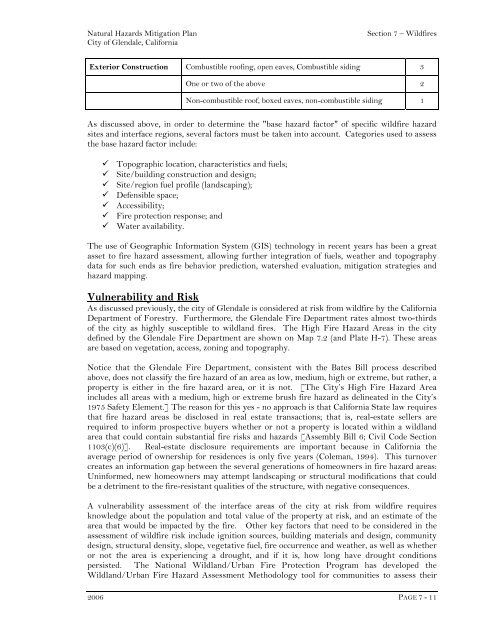Glendale (PDF) - Hazard Mitigation Web Portal - State of California
Glendale (PDF) - Hazard Mitigation Web Portal - State of California
Glendale (PDF) - Hazard Mitigation Web Portal - State of California
- No tags were found...
Create successful ePaper yourself
Turn your PDF publications into a flip-book with our unique Google optimized e-Paper software.
Natural <strong>Hazard</strong>s <strong>Mitigation</strong> PlanCity <strong>of</strong> <strong>Glendale</strong>, <strong>California</strong>Section 7 – WildfiresExterior Construction Combustible ro<strong>of</strong>ing, open eaves, Combustible siding 3One or two <strong>of</strong> the above 2Non-combustible ro<strong>of</strong>, boxed eaves, non-combustible siding 1As discussed above, in order to determine the "base hazard factor" <strong>of</strong> specific wildfire hazardsites and interface regions, several factors must be taken into account. Categories used to assessthe base hazard factor include: Topographic location, characteristics and fuels; Site/building construction and design; Site/region fuel pr<strong>of</strong>ile (landscaping); Defensible space; Accessibility; Fire protection response; and Water availability.The use <strong>of</strong> Geographic Information System (GIS) technology in recent years has been a greatasset to fire hazard assessment, allowing further integration <strong>of</strong> fuels, weather and topographydata for such ends as fire behavior prediction, watershed evaluation, mitigation strategies andhazard mapping.Vulnerability and RiskAs discussed previously, the city <strong>of</strong> <strong>Glendale</strong> is considered at risk from wildfire by the <strong>California</strong>Department <strong>of</strong> Forestry. Furthermore, the <strong>Glendale</strong> Fire Department rates almost two-thirds<strong>of</strong> the city as highly susceptible to wildland fires. The High Fire <strong>Hazard</strong> Areas in the citydefined by the <strong>Glendale</strong> Fire Department are shown on Map 7.2 (and Plate H-7). These areasare based on vegetation, access, zoning and topography.Notice that the <strong>Glendale</strong> Fire Department, consistent with the Bates Bill process describedabove, does not classify the fire hazard <strong>of</strong> an area as low, medium, high or extreme, but rather, aproperty is either in the fire hazard area, or it is not. [The City’s High Fire <strong>Hazard</strong> Areaincludes all areas with a medium, high or extreme brush fire hazard as delineated in the City’s1975 Safety Element.] The reason for this yes - no approach is that <strong>California</strong> <strong>State</strong> law requiresthat fire hazard areas be disclosed in real estate transactions; that is, real-estate sellers arerequired to inform prospective buyers whether or not a property is located within a wildlandarea that could contain substantial fire risks and hazards [Assembly Bill 6; Civil Code Section1103(c)(6)]. Real-estate disclosure requirements are important because in <strong>California</strong> theaverage period <strong>of</strong> ownership for residences is only five years (Coleman, 1994). This turnovercreates an information gap between the several generations <strong>of</strong> homeowners in fire hazard areas:Uninformed, new homeowners may attempt landscaping or structural modifications that couldbe a detriment to the fire-resistant qualities <strong>of</strong> the structure, with negative consequences.A vulnerability assessment <strong>of</strong> the interface areas <strong>of</strong> the city at risk from wildfire requiresknowledge about the population and total value <strong>of</strong> the property at risk, and an estimate <strong>of</strong> thearea that would be impacted by the fire. Other key factors that need to be considered in theassessment <strong>of</strong> wildfire risk include ignition sources, building materials and design, communitydesign, structural density, slope, vegetative fuel, fire occurrence and weather, as well as whetheror not the area is experiencing a drought, and if it is, how long have drought conditionspersisted. The National Wildland/Urban Fire Protection Program has developed theWildland/Urban Fire <strong>Hazard</strong> Assessment Methodology tool for communities to assess their2006 PAGE 7 - 11
















